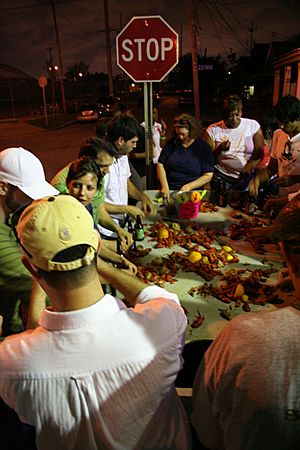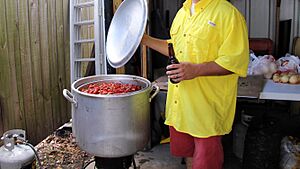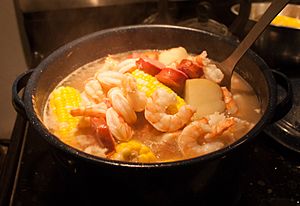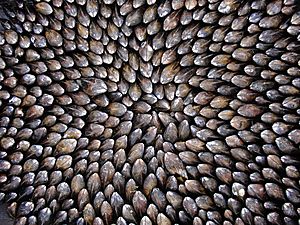Seafood boil facts for kids
A seafood boil is a fun get-together where people cook and eat lots of seafood, like shrimp, crabs, or crawfish. Different places have their own special ways to make seafood boils. They use different types of seafood, side dishes, and cooking methods like boiling or steaming. Sometimes, communities or groups hold these boils to raise money or just to bring people together. It's a bit like a big picnic or a barbecue. Families and friends also have seafood boils for weekend fun or on holidays like Memorial Day and Independence Day. Even though seafood boils are common near the coast, you can find them in other places too!
Contents
Louisiana Seafood Boils
In Louisiana, seafood boils are a big part of Cajun tradition. You can find them all over Louisiana and along the Gulf Coast. The most famous type is the crawfish boil.
Crawfish Fun in Louisiana
The Breaux Bridge Crawfish Festival in Louisiana is a huge event. It's known as one of the top food festivals in the USA and celebrates Cajun music and culture. Many churches and groups hold crawfish boils to raise money in the spring.
Universities also have their own boils. Tulane University hosts an event called "Crawfest" every April. The University of New Orleans has a crawfish boil for students at the end of the spring semester. Smaller boils happen in backyards and parks from April to June. People in Louisiana usually eat crawfish and crabs with their hands, without special tools.
Crawfish are often a popular choice because they can be quite affordable. This makes them a great option for cooking for many people.
How a Louisiana Boil Works
A seafood boil usually uses a very large pot, often 60 to 80 quarts big. This pot has a strainer inside and is heated by a propane burner. Some people use a net or a wire scoop instead of a strainer.
The seasonings are very important! They can include special crab boil packets, cayenne pepper, hot sauce, salt, lemons, and bay leaf. You'll often find corn on the cob, new potatoes, onions, and garlic cooked with the shrimp and crawfish. Some people also add smoked sausage or mushrooms.
There's a friendly debate about whether to "purge" crawfish first. This means covering them with clean water and salt to make them get rid of impurities. Some people say it works, others say it's not needed.
The "Boil Master" is the person in charge. They make sure everything goes into the pot in the right order and cooks for the correct time. There's no single "right" way to season a boil, and many experienced cooks just go by taste. Often, the seafood boils for a short time, then soaks with the heat off.
After cooking, the food is drained and poured onto a table covered with newspaper. Sometimes, it's even dumped into a pirogue, which is a traditional boat used by crawfishermen. People usually add hot sauce, lemons, and melted butter. Some families like to use Italian salad dressing or ketchup.
Georgia and South Carolina Boils
Coastal Georgia and South Carolina have two main types of seafood gatherings.
Lowcountry Boil
One type is very similar to a Louisiana boil. It usually includes shrimp, corn on the cob, sausage, and red potatoes. Sometimes ham is added too. This dish is part of Lowcountry cuisine. It's known by several names, like Frogmore Stew, Beaufort Stew, or Lowcountry Boil. These boils are often a bit milder than Louisiana ones. For example, a Lowcountry recipe might use a mix of hot and mild seasonings. Louisiana recipes often start with strong crab boil packets and add lots of cayenne pepper. While shrimp are most common, crabs or crawfish might be included if they are available. This is different from Louisiana, where boils usually focus on just one type of seafood.
Frogmore is a community in South Carolina. The name "Frogmore Stew" was created in the 1960s by Richard Gay, who owned a fish company. This stew became much more famous after it was shown on the cover of Gourmet Magazine in the 1980s.
The Lowcountry Boil might have been influenced by Louisiana cooking. Both areas share French, Spanish, African, and Caribbean influences. Cooking for many people quickly was important, and the boil was an easy way to prepare all the food at once.
A very large Lowcountry Boil happens every July at the Beaufort Water Festival. This event feeds 2,400 people! The recipe uses huge amounts of shrimp, corn, sausage, and seafood seasoning. It's served with coleslaw, iced tea, rolls, and watermelon.
Oyster Roasts
The other popular event is the Oyster Roast. For this, a metal sheet or grill is placed over hot coals. Oysters are piled onto the grill after being washed. Wet burlap sacks are put over the oysters, which makes them half-grilled and half-steamed. A shovel is used to scoop them onto nearby tables. The oyster shells pop open, and the oysters are ready to eat. This is very popular in winter when oysters are at their best, and the hot fire helps keep people warm.
Both Lowcountry Boils and Oyster Roasts are often big social events. Neighbors, families, and friends gather to spend time together. Music and dancing, especially the Carolina shag, are also common at these parties.
Chesapeake Bay Crab Feasts
The Chesapeake Bay is a large water system in North America. It's famous for its blue crabs, Chincoteague oysters, and clams. This area is between the South and Mid-Atlantic states, so it shares cooking traditions with both. "Crab houses" or "Crab shacks" serve freshly steamed crabs along the bay.
In Maryland, a "Crab Feast" is a popular event for friends. They don't call it a "Crab Boil" like in Louisiana. The cooking method is steaming, not boiling, but the event is very similar. Crab pots have a raised bottom to keep a basket above the liquid. A few inches of beer or water mixed with vinegar are brought to a boil. The crabs are put in the basket and covered with a seasoning mix, usually Old Bay. Then they are steamed.
After about twenty minutes, the bright red crabs are ready. They are poured onto trays or platters. Tables are covered with brown paper, and people use wooden mallets and knives to crack the shells and get the meat. Common side dishes are cole slaw and corn on the cob.
New England Clam Bakes
In New England, a clam bake is traditionally done right on a beach. A pit is dug in the sand and lined with stones. A fire is built on top of these stones using driftwood. Once the fire dies down, seafood is placed on the hot stones. It's then covered with seaweed and a canvas tarp. The heat from the stones and steam from the seaweed cook the food. While lobster is often part of clam bakes, some say it might not cook completely this way.
An easier option is the New England Clam Boil. Like in other regions, corn, potatoes, and sausage are often added. Recipes from this area usually add very few seasonings, or none at all. Beer is often used as the liquid for boiling.
French Mussel Bake (Éclade des Moules)
The Charente-Maritime area of France, near the Bay of Biscay, is known for its many mussels. The Éclade des Moules (or Terré de Moules) is a special mussel bake often held on the beaches outside of La Rochelle.
For this bake, mussels are arranged in circles on a wooden plank. The hinged part of the shell faces up. Pine needles are piled on top, about a foot deep, and then set on fire. The needles burn quickly, making a rich, smoky scent. A few minutes after the fire goes out, the ashes are swept away. The mussels are then eaten directly from their shells with country bread, butter, and white wine.





